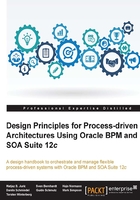
Strategy models
Strategy models that can be used to further motivate their KPIs are depicted at the value chain level.

Figure 11: Building the strategy model for the strategy "Become a market leader"
These visual maps leverage existing process documentation and match it with current business trends and existing reference models. These models depict processes and associated organizational aspects encompassing cross-departmental views on higher levels and concrete processes down to level 3. From there, they prioritize distinct processes and decide on one of several modernization strategies—process automation being just one of several!
So, in the proposed methodology in the following diagram, in the Define strategy and performance measures (KPIs), the team down-selects for each business process or even subprocess one or several means to improve process efficiency or transparency.
Typically, these means are defined as "supporting capabilities". These are a technique, a tool, or an approach that helps to modernize a business process. A few typical supporting capabilities are mentioned here:
- Explicit process automation (the topic of the next chapter)
- Implicit process handling and automation inside a packaged application, such as SAP ERP or Oracle Siebel
- Refactored COTS existing application
- Business process outsourcing
- Business process retirement
The way toward establishing these supporting capabilities is defined through a list of potential modernization strategies. Several of the modernization strategies relate to the existing applications that support a business process, such as refactoring, replacement, retirement, or re-interfacing of the respective supporting applications. The application modernization strategy that we are most interested in this and the next chapter is establish explicit automated process.
It is a best practice to create a high-level process map and define for each of the processes whether to leave it as it is or to depict one of several modernization strategies. When several modernization strategies are found for one process, we can drill down into the process through a hierarchy and stop at the level on which there is a disjunct modernization strategy.

Figure 12: Business process automation as just one of several process optimization strategies
Note
The preceding figure is based on the BPTrends Process Change Methodology introduced in the Business Process Change book by Paul Harmon.
Again, just one of these technical capabilities in strategic BPM is the topic of this chapter and book: process automation. It is not feasible to suggest automating all the business processes of any organization.